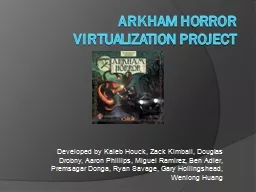

Developed by Kaleb Houck Zack Kimball Douglas Drobny Aaron Phillips Miguel Ramirez Ben Adler Premsagar Donga Ryan Savage Gary Hollingshead Wenlong Huang Brief Introduction Virtualization effort of Arkham Horror Board Game ID: 230896
Download Presentation The PPT/PDF document "Arkham Horror Virtualization Project" is the property of its rightful owner. Permission is granted to download and print the materials on this web site for personal, non-commercial use only, and to display it on your personal computer provided you do not modify the materials and that you retain all copyright notices contained in the materials. By downloading content from our website, you accept the terms of this agreement.
Slide1
Arkham Horror Virtualization Project
Developed by Kaleb Houck, Zack Kimball, Douglas Drobny, Aaron Phillips, Miguel Ramirez, Ben Adler, Premsagar Donga, Ryan Savage, Gary Hollingshead, Wenlong HuangSlide2
Brief Introduction
Virtualization effort of Arkham Horror Board GameWill be developed for two platforms: Linux and Table SystemOur team will be doing development using Agile methods.Our project will be developed in a highly modular fashion using Unicon. We will be using a virtual development environment called Assembla.We will be discussing in this presentation what has been done by the three sub teams : Team Gary, Team Doug, and Team Ben.Slide3
Combat (Collaboration)Slide4
Combat (Activity)Slide5
Sealing a Gate (Sequence)Slide6
Dice DemonstrationSlide7Slide8
Mythos
Common Item
Arkham
Event
Decks
Card
Many to many relationshipSlide9
#############################
# This is a record of a card. Opt-int to use records instead# of classes. The fields of a record are accessed the same way# (with a '.') and can be procedures. # name = Card name# text = Card text# deck = Deck the card belongs to# frontPic = Picture to put on front of card# backPic = Picture to put on the back of the card# total = Number of cards left in deck to draw or total cards to put in deck
#
cUse
= link to procedure that gets called when used
#
cDrop
= link to procedure that gets called when dropped
#
cPickup
= link to procedure that gets called when picked up
#
handCost
= how many hands needed to use
# exhausted = yes or no for exhausted or not
##############################
record Card(name, text, deck,
frontPic
,
backPic, total,
cUse, cDrop, cPickup,
handCost, exhausted)local lMythosDeck
local lArkhamEventDecklocal lOtherworldEventDeck
local lNormalItemDecklocal lMagicItemDeck
local lSpellDecklocal lSkillDecklocal
lHenchmenDeckSlide10
START MENUSlide11
Movement Activity GraphSlide12
Location Pathing
Locations have a list of all adjacent locationsCalculates all paths of length 9Removes paths without destinationTruncates locations after the destinationFinds shortest listSlide13
SamplesSlide14
Environment and Player Character Classes
Stat TablesHouses many relevant player stats within an easily accessed tableTwo Tables: BaseStatsTable and BuffStatsTableBuff SystemAllows for handling of multiple independent stat bonus effects with limited durations.The Buff Object consists of:Name: Expiration: Names of the period in which this buff is to expireCommon expirations are:Combat: These buffs are discarded after each combat turn
Turn: These buffs expire at the end of the player’s current turn
Phase: These buffs expire at the end of the current phase.
Upkeep: These buffs expire at the start of next Upkeep Phase
Passive: These buffs expire when the item giving the benefit is discarded (handled by discard() method)
Effects(list): the list of 1 or more stat modifications for this given buff
It is a list of pairs [ “stat”, magnitude ] , where the “stat” is the key for the proper stat in the
StatTables
and the magnitude is the (+/-) integer.
Conditions(list): used to allow for the buffs that have conditions attached.
Example: [“type”, “cultist”] implies the buff only affects cultist type creatures
Example: [“
locationtype”,”street
”] implies this buff only works when you are tested and found to be in a streetSlide15
Player Character Class
Stat SlidersImplemented in two parts: BaseStatsTable and three integer variables:Mobilityslider: controls the slider of Speed SneakCombatslider: controls the slider of Fight WillMentalslider : controls the slider of Lore
Luck
Each of these integers is contained within the range of 0 to 3
When the character is initialized, their stats in the
BaseStatsTable
is set to the value on the far left, and the sliders are all set to a value of 0
StatusTable
There are many toggles that can be placed on your character, these have all been migrated to the
StatusTable
, under their appropriate keys.Slide16
Environment Class
Player TableContains specific instances of the player character classThe keys for these are player1 through player’n’ in order to prevent odd player names from interfering with the table’s functionDeck TableContains specific instances of the deck class, accessed by giving a ‘key’ that uniquely identifies the deckDrawing a common item is as easy as DeckTable[“common”].DrawCard()This table has the potential to hold every deck, from items to encounter cards, to the gate and monster decks.Slide17
Key
Value“Player1”<class> object“Player2”<class> object….
….
“Player n”
<class
> object
….
…..
variable
Value
Name
“Bobby”
….
….
BaseStatsTable
<table>
object
….
….
BuffList
<list> object
BuffStatsTable
<table> object
Etc..
Etc…
Player-Character class
Player Table
Key
Value
MaxStamina
6
MaxSanity
4
…
…
Speed
2
Sneak
0
Etc..
Etc..
BaseStatsTable
Environment Class
Variable
Value
PlayerTable
<table> object
DeckTable
<table>object
….
….
CurrentPlayer
<string>CurrentPhase<string>
PlayerTable
[“Player1”].
GetStat
(“
MaxStamina
”)Slide18Slide19
Collaboration diagramSlide20
Sequence diagramSlide21
method
OnZoom(ev) w:=BoardImage.w_spec h:=BoardImage.h_spec x:=&x-BoardPanel.x_spec y:=&y-BoardPanel.y_spec if (
BoardImage.w
=
BoardPanel.w_spec
) then {
BoardImage.set_size
(w*5, h*5)
x:=x*5-BoardPanel.w_spec/2
y:=y*5-Boardpanel.h_spec/2
MAXx:=BoardImage.w_spec-BoardPanel.w_spec
MAXy
:=
BoardImage.h_spec-BoardPanel.h_spec
if (x<0) then x:=0
if (y<0) then y:=0
if (x>MAXx) then x:=MAXx
if(y>
MAXy) then y:=
MAXy BoardImage.set_pos(-x, -y)
VerticalZoomScrollBar.set_value(50*y/MAXy
) HorizontalZoomScrollBar.set_value(50*x/MAXx) overlay_set_1.set_which_one(overlay_item_1)
} else { BoardImage.set_size(w/5, h/5)
BoardIMage.set_pos(0,0) overlay_set_1.set_which_one(overlay_item_2) }
resize()
endSlide22
method OnHorizontalZoomScrollBarPress(
ev) y:=BoardImage.y_spec MAXx:=BoardImage.w_spec-BoardPanel.w_spec x:=HorizontalZoomScrollBar.value*MAXx/50 BoardImage.set_pos(-x, y) resize()endSlide23
Zoomed out Map Game Display
Equipment Stats Display
Investigator Stats Display
Main Game Display
Player clicks on map
Player clicks the zoom icon
Player clicks the investigator
Player clicks return
Player clicks an item in the list
Player clicks the investigatorSlide24
Chatbox
Chatbox is an optional feature wherein the users can chat with each other during playtime.Slide25
ChatboxSlide26
ChatboxSlide27
Chatbox